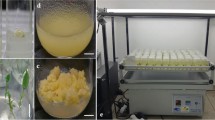Summary
Optimal conditions for the growth of Drosophyllum lusitanicum Link. in suspension culture and for the production of plumbagin (5-hydroxy-2-methyl-3,4-naphthoquinone) were pH 3.5 with 10 g sucrose/l.
Similar content being viewed by others
References
Culham, A. and Gornall, R.J. (1994). Biochemical Systematics and Ecology 22, 507–515.
Didry, N., Dubrevil, L. and Pinkas, M. (1994). Pharmazie 49, 681–683.
Endress, R. (1994). Plant Cell Biotechnology. Springer-Verlag Berlin Heidelberg.
Finnie, J.F. and Stadent, J. (1993). Drosera spp. (Sundew): Micropropagation and the in vitro production of plumbagin. In: Biotechnology in Agriculture and Forestry, Medical and Aromatic Plants V., Bajaj, Y.P.S., eds., pp. 164–177, Springer-Verlag Berlin.
Fujii, N., Yamashita, Y., Arima, Y., Nagashima, M. and Nakano, H. (1992). Antimicrobial Agents and Chemoterapy 36, 2589–2594.
Fujita, Y. (1988). Shikonin: Production by Plant (Litospermum erythrorhizon) Cell Cultures. In: Biotechnology in Agriculture and Forestry, Medicinal and Aromatic Plants I., Bajaj, Y.P.S., eds., pp. 225–236, Springer-Verlag Berlin.
Gamborg, O.L., Miller, R.A. and Ojima K. (1968). Exp. Cell Res. 50, 151–158.
Hassanali, A. and Lwande, W. (1989). Antipest Secondary Metabolites from African Plants. In: Insecticides of Plant Origin, J.T. Arnanson, B.J.R. Philogene & P. Morand, eds., pp. 78–94, American Chemical Society, Washington.
Hüsemann W., Callies R. and Leibfritz D. (1992). Bot. Acta 105, 116–119.
Ikeda, T., Matsumoto, T. and Noguchi, M. (1976). Agr. Biol. Chem. 40, 1765–1770.
Juniper, B.E., Robins, R.J. and Joel, D.M. (1989). The Carnivorous Plants, Academic Press, London.
Kitanov, G.M. and Pashankov, P.P. (1994) Pharmazie 49, 462.
Larsen, J., Lange, L. and Olson, L.W. (1992). Journal of Phytopathology - phytopathologische Zeitschrift 4, 336–342.
Mizukami, H., Konoshima, M. and Tabata, M. (1977). Phytochemistry 16, 1183–1186.
Murashige, T. and Skoog, F. (1962). Physiol. Plant 15, 473–497.
Nahálka, J., Blanárik, P., Gemeiner, P., Matúšová, E., Partlová, I. (1996). Journal of Biotechnology 000, 000–000, in press.
Petersen, M. (1994). Coleus spp.: In Vitro Culture and the Production of Forskolin and Rosmarinic acid. In: Biotechnology in Agriculture and Forestry, Medical and Aromatic Plants VI., Bajaj, Y.P.S., eds., pp. 69–92, Springer-Verlag Berlin.
Pierik, R.L.M. (1987). In Vitro Culture of Higher Plants, Martinus Nijhoff, Dordrecht.
Author information
Authors and Affiliations
Rights and permissions
About this article
Cite this article
Nahálka, J., Blanárik, P., Gemeiner, P. et al. The chemical/osmotic conditions for growth and plumbagin accumulation of Drosophyllum lusitanicum Link. suspension cultures. Biotechnol Lett 18, 1453–1458 (1996). https://doi.org/10.1007/BF00129354
Issue Date:
DOI: https://doi.org/10.1007/BF00129354




